

Banning books: Are we still doing that? Why? I am surprised when I read about attempts to ban notable books from schools because kids today watch far more graphic stuff on TV and in movies than what you will find in most of the banned books. (Not to beat a dead horse or teddy bear, but witness Miley Cyrus’ sexually charged performance at the VMAs.) I remain stunned every time I go the movies and see parents there with kids far too young for the content. Many 10-year-olds faithfully watch the TV show “Glee,” which addresses a lot of adult themes. But here is yet another news story about a lawmaker attempting to ban a book, Toni Morrison’s “The Bluest Eye.” According to the official summary of the book: Pecola Breedlove, a young black girl, prays every day for beauty. I am interviewing two authors about their new books on children and education for the AJC Decatur Book Festival Saturday.
That is not the case in America where we even want to monitor what older teens read in our schools. INFOGRAPHIC: Top Ten Banned Or Challenged Books Of 2010. Why I Banned A Book. First published on College & Research Libraries News "Heresy was good: heresy meant opportunity.

" --Moneyball: The Art of Winning an Unfair Game by Michael Lewis Yes, I banned a book. I am a seasoned librarian and academic library director and a supporter of free speech and democracy, but I banned a book. The term heresy quickly comes to mind in the world of librarianship, but the story is much deeper than it first appears. The story begins with two staff members and one librarian who enthusiastically created and ran a week of interactive programs for banned book week. He was joking, but his statement emphasized that as long as one book can be banned, any book is a target. Two of my staff members and one librarian thought it over and came to me a couple days later, suggesting that we should, indeed, ban it during Banned Books Week. He agreed to participate. Only five of us knew about the project. Miller enjoys a good deal of popularity on our campus and in our Northern Tier area. A worldwide literacy project to celebrate the freedom to read.Banned Books Awareness.
About Banned & Challenged Books. The American Library Association promotes the freedom to choose or the freedom to express one's opinions even if that opinion might be considered unorthodox or unpopular, and stresses the importance of ensuring the availability of those viewpoints to all who wish to read them.
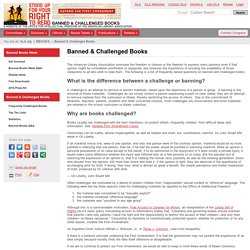
The following is a list of frequently asked questions on banned and challenged books: What is the difference between a challenge or banning? A challenge is an attempt to remove or restrict materials, based upon the objections of a person or group. A banning is the removal of those materials. Challenges do not simply involve a person expressing a point of view; rather, they are an attempt to remove material from the curriculum or library, thereby restricting the access of others. Why are books challenged? Books usually are challenged with the best intentions—to protect others, frequently children, from difficult ideas and information.
. — On Liberty, John Stuart Mill As Supreme Court Justice William J. No. Books Under Fire. Printer-friendly version Eleanor Cumberland recalls vividly the school desegregation wars that erupted in the farming community of Hillsboro, Ohio, a half-century ago.
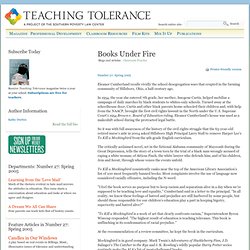
In 1954, the year she entered 7th grade, her mother, Imogene Curtis, helped mobilize a campaign of daily marches by black students to whites-only schools. Turned away at the schoolhouse door, Curtis and other black parents home-schooled their children and, with help from the NAACP, brought the first civil rights lawsuit in the North under the U.S. Supreme Court's 1954 Brown v. Board of Education ruling. Controversy Over N-Word in 'To Kill A Mockingbird' Reporter: Ashley Singh l Videographer: Nick King Halifax Co., VA - There's a controversy brewing in Halifax County and it's over the use of the N-word in a production of To Kill a Mocking Bird.
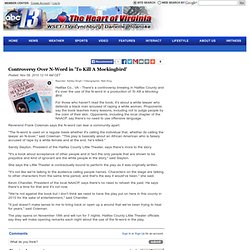
For those who haven't read the book, it's about a white lawyer who defends a black man accused of raping a white woman. Proponents say the book teaches many lessons, including not to judge people by the color of their skin. Opponents, including the local chapter of the NAACP, say there's no need to use offensive language. Banned Books Awareness: To Kill a Mockingbird.
Harper Lee’s immortal classic, To Kill a Mockingbird, was first published in 1960 to instant acclaim- despite her editors’ warnings that it probably wouldn’t sell all that well.
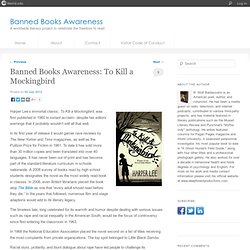
In its first year of release it would garner rave reviews by The New Yorker and Time magazines, as well as the Pulitzer Prize for Fiction in 1961. To date it has sold more than 30 million copies and been translated into over 40 languages. It has never been out of print and has become part of the standard literature curriculum in schools nationwide. To Kill a Mockingbird. To Kill a Mockingbird By Harper Lee Summary: To Kill A Mockingbird is set in Alabama, three years after the Great Depression.
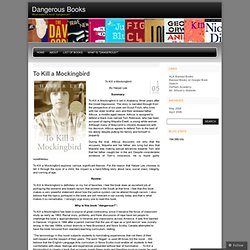
The story is narrated through from the perspective of six-year-old Scout Finch, who lives with her older brother Jem and their widowed father Atticus, a middle-aged lawyer. Atticus is assigned to defend a black man named Tom Robinson, who has been accused of raping Mayella Ewell, a young white woman. During the trial, Atticus discovers not only that the accusers, Mayella and her father, are lying but also that Mayella was making sexual advances towards Tom and that her father caught her in the act.